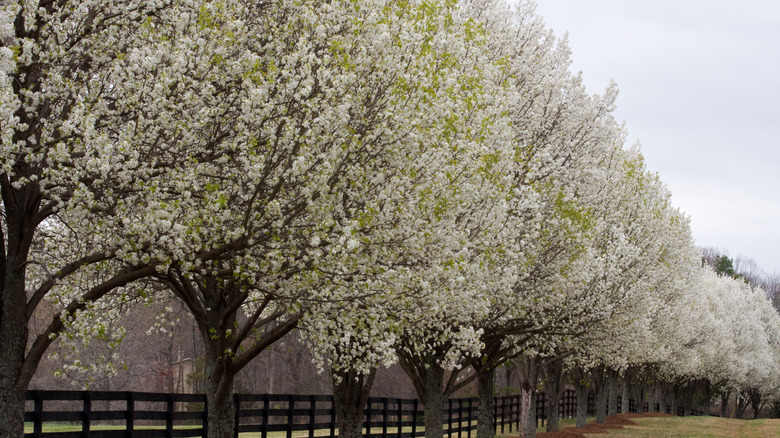Bradford Pear Vs. Dogwood Tree: How To Spot The Difference
Bradford pear (Pyrus calleryana) and flowering dogwood trees (Cornus florida) are easy to spot during the early spring and autumn months. Both types of trees can reveal soft white flowers in the springtime, while their leaves transform into beautiful reds in the autumn months. Needless to say, it can be difficult to tell both of these trees apart at first glance. By knowing their maximum heights, and by looking at their leaves, flowers, and trunks, though, you can learn how to quickly tell Bradford pear and dogwood trees apart from one another.
One of key differences between these two types of trees lies in their average heights. In general, flowering dogwoods are considered to be on the smaller side, and you're most likely find them along the edges of forests and woodland areas. It's also relatively easy to grow and care for dogwood trees at home. Bradford pears, on the other hand, tend to be taller and aren't as suitable for yards. While a Bradford pear can grow between 30 and 50 feet tall, dogwood trees generally range between 15 and 25 feet. For trees that are not yet full-grown though, it may be difficult to tell them apart. Another way you can do this is by looking at their trunks and branches. The overall bark color of the Bradford pear tree is either gray or reddish-brown, and its branches are vulnerable to tearing during high winds or thunderstorms. Dogwood trees are more resistant to storm damage. Also, their trunks can form scales with age, and the bark can range from light gray to dark brown in color.
Bradford pear and dogwood trees have different leaves, flowers, and other traits
Both the Bradford pear and dogwood tree are among the many trees that produce white flowers in the springtime. However, upon closer inspection, you can tell them apart from one another due to key differences in their fruit and flowers. On the Bradford pear, the flowers have five petals each, and they are creamy white in color. Dogwoods, on the other hand, boast larger flowers that aren't always white — in fact, they can be pink, gold, and green. Flowers may also have four or five petals a piece.
You may also be able to tell the difference between these two trees by looking at their leaves. First, the Bradford pear tree tends to have glossy leaves that are dark green on the upper portion, and green underneath. During the fall, they can turn red, purple, or bronze. The leaves of a flowering dogwood tree are usually green on top and glossy on the bottom, and they boast reddish-purplish colors in the autumn months.
The Bradford pear is considered the most common type of tree in its cultivar. You can find these trees all across the mainland U.S., although they are actually native to parts of eastern Asia. Due to its invasive status, you may want to consider native alternatives to grow instead of the Bradford pear tree, including the dogwood. Unlike the Bradford pear tree, flowering dogwood is native to areas of the U.S., especially the eastern regions. It's also considered indigenous to eastern Mexico and southeastern Canada.

